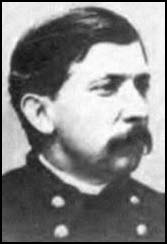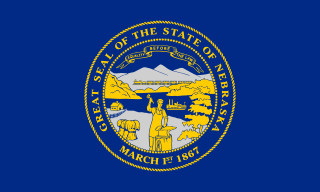
The Powder River Expedition of 1865 also known as the Powder River War or Powder River Invasion, was a large and far-flung military operation of the United States Army against the Lakota Sioux, Cheyenne, and Arapaho Indians in Montana Territory and Dakota Territory. Although soldiers destroyed one Arapaho village and established Fort Connor to protect travelers on the Bozeman Trail, the expedition is considered a failure because it failed to defeat the Indians and secure peace in the region.

James William Forsyth was a U.S. Army officer and general. He was primarily a Union staff officer during the American Civil War and cavalry regimental commander during the Indian Wars. Forsyth is best known for having commanded the 7th Cavalry at the Wounded Knee Massacre on December 29, 1890 during which more than 150 men, women, and children of the Lakota were killed and 51 were wounded.

Thomas Casimer Devin was a United States Army officer and general. He commanded Union cavalry during the American Civil War and during the Indian Wars.

John Irvin Gregg was a career U.S. Army officer. He fought in the Mexican–American War and during the American Civil War as a colonel and near the end of the war as a brevet general in the Union army. In 1866, he was nominated and confirmed as a brevet major general of volunteers and a brevet brigadier general in the Regular Army, both to rank from March 13, 1865.

The state of Iowa played a role during the American Civil War in providing food, supplies, and troops for the Union army, though its contributions were overshadowed by larger and more populated eastern states.

Francis Marion Drake was an American merchant, lawyer, banker and politician. He fought in the American Civil War and later became the 16th Governor of Iowa. He is the namesake of Drake University.
The 30th Regiment Wisconsin Volunteer Infantry was an infantry regiment that served in the Union Army during the American Civil War.

The 1st Regiment Nebraska Volunteer Infantry was an infantry regiment that served in the Union Army during the American Civil War. It was initially organized to protect the Nebraska Territory from Indian attacks, but primarily served in the Western Theater before being reorganized and sent to the frontier.
The 1st Regiment Nebraska Volunteer Cavalry was a cavalry regiment that served in the Union Army during the American Civil War.
The 7th Regiment Iowa Volunteer Cavalry was a cavalry regiment that served in the Union Army during the Indian Wars.

The area that eventually became the U.S. state of Montana played little direct role in the American Civil War. The closest the Confederate States Army ever came to the area was New Mexico and eastern Kansas, each over a thousand miles away. There was not even an organized territory using "Montana" until the Montana Territory was created on May 26, 1864, three years after the Battle of Fort Sumter. In 1861, the area was divided between the Dakota Territory and the Washington Territory, and in 1863, it was part of the Idaho Territory.
The 1st Dakota Cavalry was a Union battalion of two companies raised in the Dakota Territory during the American Civil War. They were deployed along the frontier, primarily to protect the settlers during the Sioux Uprising of 1862.

Theodore Washington Brevard Jr. was an American military officer best known for having served in the Confederate States Army. During his tenure with the Confederate army, he eventually reached the rank of Brigadier-General. Brevard was captured by the forces of General George Custer and imprisoned at Johnson's Island. He later died in 1882.
Edward Banker Willis was a United States military officer during the American Civil War. He participated in the Trans-Mississippi Theater, fighting rebels and hostile native Americans in the frontier of Arizona and New Mexico.
Edwin Vose Sumner Jr. was a general in the United States Army. Born at Carlisle, Pennsylvania; he was the son of General Edwin Vose Sumner, one of the oldest generals to serve during the American Civil War.

The Governor's Guards is a historic unit of the Florida Army National Guard, stationed in Tallahassee, Florida. Its current designation is Troop C, 1st Squadron, 153rd Cavalry. The unit has one of the oldest continuous lineages in the Florida National Guard with history dating back to the first militia units formed in the town in 1836. In 1857, Captain John Pakhill, his brother Samuel M. Parkhill, and Theordore Brevard, Jr. formed a mounted company of "Leon Volunteers" to fight in the Third Seminole War, where John Parkhill was killed in action. John Parkhill's cousin, Captain George W. Parkhill and his brother, Richard C. Parkhill formed a new company called the "Governor's Guards" circa 1859-1860 which later changed its name to "Howell Guards" and fought with the Second Florida Infantry during the Civil War. After the war, the company reorganized as "Governor's Guards", a local militia company, under the command of Captain Alexander Moseley and have had a near-continuous lineage henceforth. The Governor's Guards served as an infantry unit for most of its existence, including in the Civil War, World War I, World War II, the Iraq War and the Global War on Terrorism. The unit consolidated with the Franklin Guards, a detachment in Apalachicola and since 2007 has been Charlie Troop, a dismounted infantry reconnaissance troop.

Leonard Wright Colby, who hailed from the U.S. state of Ohio, was a leader of the first Nebraska National Guard, American Indian Wars veteran, state senator of Nebraska and United States Assistant Attorney General. As a teenager, he fought in the American Civil War. During his career, he commanded both Nebraska and U.S. troops. He served as commander of the Nebraska National Guard.












